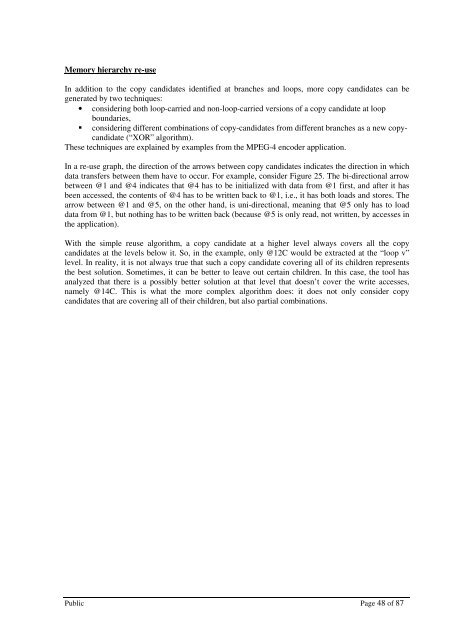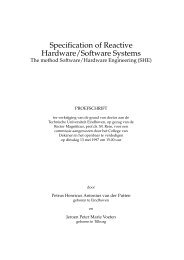MNEMEE - Electronic Systems - Technische Universiteit Eindhoven
MNEMEE - Electronic Systems - Technische Universiteit Eindhoven
MNEMEE - Electronic Systems - Technische Universiteit Eindhoven
Create successful ePaper yourself
Turn your PDF publications into a flip-book with our unique Google optimized e-Paper software.
Memory hierarchy re-use<br />
In addition to the copy candidates identified at branches and loops, more copy candidates can be<br />
generated by two techniques:<br />
• considering both loop-carried and non-loop-carried versions of a copy candidate at loop<br />
boundaries,<br />
considering different combinations of copy-candidates from different branches as a new copycandidate<br />
(“XOR” algorithm).<br />
These techniques are explained by examples from the MPEG-4 encoder application.<br />
In a re-use graph, the direction of the arrows between copy candidates indicates the direction in which<br />
data transfers between them have to occur. For example, consider Figure 25. The bi-directional arrow<br />
between @1 and @4 indicates that @4 has to be initialized with data from @1 first, and after it has<br />
been accessed, the contents of @4 has to be written back to @1, i.e., it has both loads and stores. The<br />
arrow between @1 and @5, on the other hand, is uni-directional, meaning that @5 only has to load<br />
data from @1, but nothing has to be written back (because @5 is only read, not written, by accesses in<br />
the application).<br />
With the simple reuse algorithm, a copy candidate at a higher level always covers all the copy<br />
candidates at the levels below it. So, in the example, only @12C would be extracted at the “loop v”<br />
level. In reality, it is not always true that such a copy candidate covering all of its children represents<br />
the best solution. Sometimes, it can be better to leave out certain children. In this case, the tool has<br />
analyzed that there is a possibly better solution at that level that doesn’t cover the write accesses,<br />
namely @14C. This is what the more complex algorithm does: it does not only consider copy<br />
candidates that are covering all of their children, but also partial combinations.<br />
Public Page 48 of 87
















